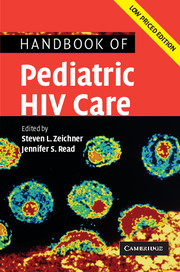Book contents
- Frontmatter
- Contents
- List of contributors
- List of abbreviations
- Foreword
- Preface
- Part I Scientific basis of pediatric HIV care
- Part II General issues in the care of pediatric HIV patients
- Part III Antiretroviral therapy
- Part IV Clinical manifestations of HIV infection in children
- 18 Cutaneous diseases
- 19 Neurologic problems
- 20 Ophthalmic problems
- 21 Oral health and dental problems
- 22 Otitis media and sinusitis
- 23 Cardiac problems
- 24 Pulmonary problems
- 25 Hematologic problems
- 26 Gastrointestinal disorders
- 27 Renal disease
- 28 Endocrine disorders
- 29 Neoplastic disease in pediatric HIV infection
- Part V Infectious problems in pediatric HIV disease
- Part VI Medical, social, and legal issues
- Appendix 1 Formulary of antiretroviral agents
- Appendix 2 National Institutes of Health sponsored clinical trials for pediatric HIV disease
- Appendix 3 Selected HIV-related internet resources
- Appendix 4 Selected legal resources for HIV-infected children
- Index
- References
24 - Pulmonary problems
Published online by Cambridge University Press: 23 December 2009
- Frontmatter
- Contents
- List of contributors
- List of abbreviations
- Foreword
- Preface
- Part I Scientific basis of pediatric HIV care
- Part II General issues in the care of pediatric HIV patients
- Part III Antiretroviral therapy
- Part IV Clinical manifestations of HIV infection in children
- 18 Cutaneous diseases
- 19 Neurologic problems
- 20 Ophthalmic problems
- 21 Oral health and dental problems
- 22 Otitis media and sinusitis
- 23 Cardiac problems
- 24 Pulmonary problems
- 25 Hematologic problems
- 26 Gastrointestinal disorders
- 27 Renal disease
- 28 Endocrine disorders
- 29 Neoplastic disease in pediatric HIV infection
- Part V Infectious problems in pediatric HIV disease
- Part VI Medical, social, and legal issues
- Appendix 1 Formulary of antiretroviral agents
- Appendix 2 National Institutes of Health sponsored clinical trials for pediatric HIV disease
- Appendix 3 Selected HIV-related internet resources
- Appendix 4 Selected legal resources for HIV-infected children
- Index
- References
Summary
Introduction
Despite advances in the treatment of HIV disease and the implementation of highly active antiretroviral therapy as the standard of care in resource-rich countries, pulmonary diseases continue to cause significant morbidity and mortality in HIV-infected pediatric patients [1]. Common pulmonary diseases seen in pediatric HIV patients include: (a) lymphoproliferative processes (lymphoid interstitial pneumonitis (LIP), pulmonary lymphoid hyperplasia (PLH)); (b) conventional infectious processes; (c) viral, bacterial, and fungal opportunistic infections pathogens; (d) disorders such as asthma/ reactive airway disease worsened by the immune dysregulation accompanying HIV infection.
Pneumocystis carinii pneumonia (PCP) remains the most common pulmonary complication of pediatric HIV infection in the United States [2]. Pulmonary tuberculosis exceeds recurrent bacterial infections or PCP as the primary clinical manifestation of pediatric HIV disease in tuberculosis-endemic countries [3]. Improvements in prophylaxis and in HIV clinical management have led to a substantial decrease in the incidence of PCP [4]. LIP is the second most common pulmonary complication of pediatric HIV infection [2] and historically has been associated with improved survival in affected patients, including those in developing countries [5].
Recent studies suggest that LIP is a cytokine-mediated process mediated by immune responses against HIV antigens and/or other pathogens (e.g. EBV) [6].
Pediatric HIV patients may develop a variety of immune-related pulmonary disorders. These include T-cell alveolitis due to HIV-specific cytotoxic and NK-like CD8+ CTLs, activated alveolar macrophage accumulation, hyperproduction of macrophage-derived cytokines, pulmonary neutrophilia, and the loss of NK and HIV-specific CTL activities [6].
- Type
- Chapter
- Information
- Handbook of Pediatric HIV Care , pp. 567 - 587Publisher: Cambridge University PressPrint publication year: 2006



